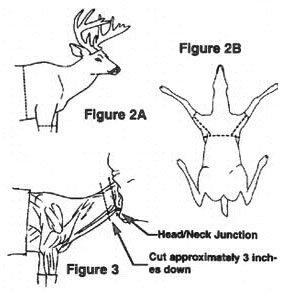Because of the various diseases that wild game can transmit to humans, always use extreme caution when handling the carcass. Use rubber or latex gloves and thoroughly wash your hands with soap and water after handling.
PICTURES
Take plenty of pictures not only for yourself but for your taxidermist. There are no two animals alike. Have a clear picture with you, especially with fish.
CAPING FOR A SHOULDER MOUNT:
With a sharp knife, slit the hide circling the body well behind the shoulder at approximately the mid-way point of the rib cage behind the front legs. Slit the skin around the legs just above the knees. An additional slit will be needed from the back of the leg joining the body cut behind the legs (Figure 2A and 2B). Be sure to cut up the back of the leg and do not cut the "arm pit" area.
Peel the skin forward up to the ears and jaws exposing the head/neck junction. Cut into the neck approximately three inches down from this junction. Circle the neck cutting down the spinal column. After this cut is complete, grasp the antler bases and twist the head off the neck. This should allow the hide to be rolled up and put in a freezer until transported to the taxidermist.
NOTES:
- Do not cut the throat or brisket. The taxidermist can always cut off the extra hide, but can't add to what isn't there.
- If there's blood on the hide wash with water or snow.
- Don't drag your animal out of the woods with a rope you can end up damaging the hide. If you have to drag use a rope around the antlers, never around the neck and drag carefully.
FISH: Do not gut your fish. If you cannot take your fish immediately to a taxidermist, wrap it in a very wet towel and put it in a plastic bag, making sure all the fins are flat against the fish's body and freeze it.
NOTES:
-A fish frozen with this method can safely be kept in the freezer for months.
-A fish will lose its coloration shortly after being caught. Take good clear pictures immediately so your taxidermist has a reference photo of what your fish looked like.
BIRDS: Do not gut the bird or ring its neck as irreparable damage may occur. If you cannot take your bird immediately to a taxidermist, gently tuck the head under the wing. Also, wrap the legs and feet in a wet cloth or paper towel. Put the bird in a plastic bag and freeze. Be careful not to damage the feathers, including the tail.
NOTES:
-Rinse off any blood on the feathers with water.
-Place a Kleenex or other soft material into and around the beak/bill keeping any fluids from getting onto the feathers.
-If the tail feathers don't fit in the bag don't bend them. It is ok for the feathers to stick out, just put a bag loosely around the tail.
SMALL MAMMALS: Do not gut the small mammals. If you cannot take your mammal immediately to a taxidermist place in the freezer whole as soon as it cools completely. Small game should be skun out by the taxidermist because they have a thin hide they spoil quickly from bacteria. To much handling can lead to hair loss from the heat of your hands especially around the ears and face.
TIPS:
- The process of skinning out a animal is best left to a taxidermist. Their experience in skinning, especially around the nose, mouth, eyes, and ears is invaluable toward producing a quality mount. Some types of damage can't be fixed by a taxidermist.
- Allot of animals are ruined in the first few hours after death. .As soon as the animal dies, bacteria begins to attack the carcass. Warm, humid weather accelerates bacteria growth. In remote areas, or areas not near your taxidermist, a competent person may be required to cape out the hide in order to preserve it.
- Use extra care when handling hollow haired animals such as a antelope and mule deer. Their hair is more acceptable to breakage.
